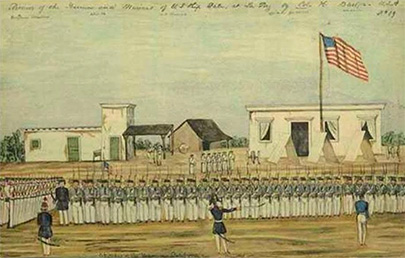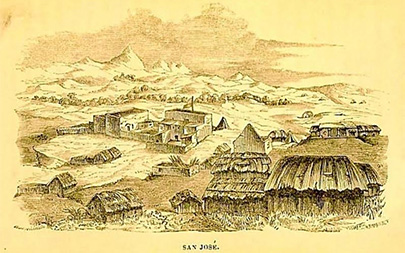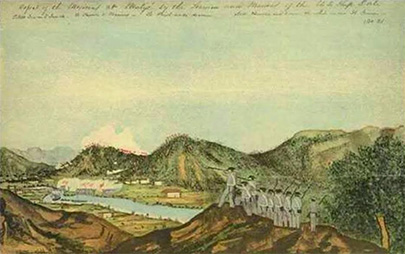 |  |
By David Kier Illustrations by William H. Meyers

In its desire to be a nation spanning the continent from the Atlantic Ocean to the Pacific, American officials made efforts to purchase northern Mexico. The region was sparsely settled and mostly ignored by Mexico City, yet Mexico refused the offers to sell it. Spain had penetrated the region and established mission colonies in the Californias and the Southwest. When Mexico gained its independence in 1821, these Spanish territories became Mexican territory. Except for around the missions of the Californias, Arizona, and New Mexico, these lands were only inhabited by the American Indians and a few hunters and migrating settlers from the East Coast.
Tensions between the United States and Mexico grew when the U.S. annexed the Republic of Texas on March 1, 1845, a territory Mexico still considered its own. On June 24, President James K. Polk ordered the U.S. Navy to seize all harbors of the Californias should war break out with Mexico. To try and find a peaceful resolution to the desires of America, Polk wanted to send a diplomat to Mexico to adjust the boundary at 32° (from El Paso, Texas west to the Pacific Ocean just above Ensenada). Mexico was not interested in any “adjustment.”
The primary goal for the United States was San Francisco Bay. An expedition was sent to Upper (Alta) California by land in advance of war, so if war was declared, American forces would be quick to raise the stars and stripes. It was known that Californians were poorly served by the government in Mexico City and U.S. forces may not face much resistance. The declaration of war was signed by Polk on May 13, 1846.
On August 17, 1846, Commodore Robert F. Stockton made the proclamation that Upper and Lower (Baja) California were both now a territory of the United States. Not one American military person had yet stepped foot in Baja California! Once the main ports of Alta California were secured, then attention was focused on the long peninsula to the south. That month, the U.S.S. Cyane with Samuel DuPont at the command, had set sail from San Pedro under orders to impose a blockade at Mazatlán. The U.S.S. Warren joined the Cyane to enforce the blockade. Next, the Cyane sailed to La Paz Bay searching for vessels to capture, and anchored at Pichilingue on September 14, 1846, the day ‘war’ came to Baja California. Several vessels anchored at La Paz (for the hurricane season) were captured.

The governor of Baja California, Colonial Francisco Palacios Miranda complied with U.S. forces to neutralize the peninsula. With no Mexican forces to counter the U.S. presence, Miranda had little alternative. Miranda confided with Commander Samuel DuPont that Mexico had left Baja California in “utter destitution” and “defenseless against even the smallest forces.” DuPont praised Miranda and the citizens of La Paz for their friendliness and cooperation in obtaining supplies.
After two weeks, the Cyane sailed north looking for gunboats reported, but only seized some small boats around Loreto and Mulegé. On October 4, the Cyane sailed across the gulf. On November 1, the Cyane headed to San Francisco, pausing at San José del Cabo for two days to take on rations and water. The people were friendly and happy to assist. Another U.S. warship, U.S.S. Dale arrived at San José del Cabo just days after the Cyane.
The above was the extent of the war in Baja California in 1846. Commodore Stockton had urged the Secretary of the Navy, George Bancroft, to retain the peninsula as “indispensable to preserve the lives of our fellow citizens… [and] to secure a permanent peace.” The flag of the United States was raised for the first time on the peninsula on March 30, 1847 at San José del Cabo. The town council had objected to the surrender demand made by Commander John B. Montgomery of the U.S.S. Portsmouth, but did not offer any resistance when 140 men came ashore. Four days later, after sailing to Cabo San Lucas, a detachment came ashore, and the flag was raised there. On April 8, the Portsmouth sailed for La Paz arriving on the 13th . The next day, a surrender demand was made and all the officials signed without resistance. U.S. ships enforced the blockade of the gulf and life was otherwise uninterrupted for the peninsula. Local officials were allowed to continue their regular duties.
One member of the United States first expeditionary force to undertake the occupation of Baja California was Lieutenant E. Gould Buffum. Buffum had anticipated a miserable time on the desert peninsula, but writes the following when he came ashore at La Paz, on July 21, 1847: “… surprised to find the prettiest town I had seen in California. The streets were lined with willow trees, which, meeting overhead, formed an arch, affording a delicious shade at midday. The houses were all of adobe, plastered white, and thatched with the leaves of the palm-tree, and were most delightfully cool. The whole beach was lined with palms, date, fig, tamarind, and coconut trees, their delicious fruits hanging upon them in clusters.” Both Governor Miranda and the Dominican missionary, Ignacio Ramirez, had complied with the neutrality and showed friendship to the invaders. Mexican army Captain Manuel Pineda, in the meantime, had been organizing a resistance with 200 men after crossing the gulf from Guaymas to Mulegé and was going to march upon La Paz. It was learned that Dominican missionary leader, Gabriel Gonzáles was also opposing the Americans and traveled to Mulegé to join Pineda.

The U.S.S. Dale arrived at Mulegé on September 30 and Lieutenant Tunis Craven came ashore under a flag of truce to inform the Mexican emissary, Sub- Lieutenant Jesús Avilez, that the Californias were American territory and they wished to protect the citizens. Avilez took the message to his superiors while Craven and company returned to the Dale until the next morning. Pineda and the Mexicans at Mulegé refused to lay down their arms and called this an unjust war of the United States against the Republic of Mexico and would “defend the town until the last drop of blood was shed.”
A landing party of eighty marines and seamen went ashore at El Sombrerito while the Dale and some launches opened their batteries on the town. Two versions of the battle are told, but in the end, Mulegé did not surrender and the Dale returned to La Paz following brief stops at Loreto and Puerto Escondido.
In November 1847, U.S. ships had succeeded in capturing Mazatlán but without substantial forces to remain in place at the captured ports, permanent occupation could not be guaranteed. While U.S. forces were away at Mazatlán, Mexican forces in Baja California organized by Captain Pineda attacked the few Americans at La Paz. The Americans survived two attacks, but Lieutenant Colonel Burton sent a courier to Monterey and a message to Mazatlán seeking additional troops. Pineda ordered a party of 150 men south to San José del Cabo to seek the surrender of the Americans. That request was spurned by Lieutenant Heyward and the U.S. force took refuge in the old mission. The Mexicans set up on a nearby hill called La Lomita. When two American whaling ships arrived they were mistaken for Navy ships and the Mexican forces retreated on November 21. Casualties on both sides were light.
Mexican resistance to the American occupation grew and their resentment of those who were friendly to the American forces would be an issue at the end of the war. Captain Pineda and his forces regrouped at San Antonio, 40 miles south of La Paz. Repeated attacks by Mexican forces against the Americans at La Paz and San José del Cabo began in January 1848 were causing many casualties and the capturing of prisoners. American reinforcements arrived and doubled the U.S. numbers. Captain Pineda was captured at San Antonio on March 27. Attention now was directed to Todos Santos where some 300 Mexican troops were reported. By the end of April, the Americans were in full control of southern Baja California. The official end of the war had been made on February 2, 1848 with the signing of the Treaty of Guadalupe Hidalgo. News of the treaty’s ratification did not arrive in Mazatlán until June 13. Americans were ordered to withdraw from the Gulf of California.

The treaty was made, Baja California was to be returned to Mexico, the border would be north of Latitude 32° with enough land to allow reasonable communication between Sonora and Baja California, above the Colorado Delta. President Polk was furious when he learned that the peninsula was negotiated away. Communication of the time was quite slow and weeks to months passed between exchanging messages.
The Baja Californians who were promised to be part of the United States feared revenge upon them by their fellow Mexicans who did not favor American occupation. On July 5, 1848, the La Paz citizens’ delegation requested formal annexation by the United States and if that failed, they would ask Great Britain. To prevent any new hostility and make the transfer of Baja California back to Mexico as peaceful as possible, the people of La Paz were offered political asylum, protection, and relocation to Alta California. Financial awards were also offered to sixty-three people who made claims against the United States. Six weeks were spent in the evacuation of those wishing to relocate north. Nearly 500 residents of La Paz and San José del Cabo were transported to Alta California by U.S. Navy ships.
The Mexican flag was raised again at La Paz on August 31, 1848.
References:
The Mexican War in Baja California by Captain Henry W. Halleck (1846-1848), edited by Doyce B. Nunnis, Jr., 1977.
The Mexican War 1846-1848, by K. Jack Bauer, 1974.
About David
David Kier is a veteran Baja traveler and the co-author of 'The Old Missions of Baja and Alta California: 1697-1834. David Kier’s research on the twenty-seven missions of Baja California was recently published in a new comprehensive book. Visit The Old Missions website for additional information.

Very excellent service, needed insurance for Mexico, price was fair. The custumer service rep was...

Thank God I had a safe trip but it did have me at peace knowing I was fully covered. The staff were...

Been going to baja for 45 years. This is best insurance company i have come accross.